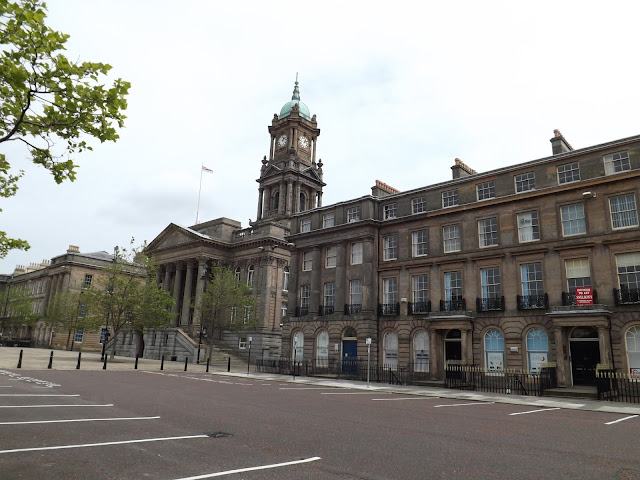We decided to see the other side of the Mersey today and so caught the ferry over to The Wirral. We went from the Pier Head Terminal and then over to the Seacombe Pier and then got off at the Woodside Pier. We were a little delayed as the Isle of Man Ferry, that is berthed just near the Pier Head, was also leaving. It is one of those catamaran wave piercing vessels so you could see right under it.
Isle of Man Ferry leaving and turning in the river ready for the crossing.
The ferry takes a route up the east bank and the commentary points out the sights to be seen. It then crosses over to the west bank and soon lands at the Seacombe Terminal having passed Wallasey Town Hall. The front faces the river so everybody enters through the backdoor!
Wallasey Town Hall.
Just at the Woodside Jetty is the U-534 exhibition. This was the last U Boat sunk in WWII. It was escaping Kiel on the day the surrender had been declared. All U Boats were supposed to be flying a black flag to signify they had surrendered. Three submarines were sailing together when they were spotted by aircraft in the Kattegatt by Denmark. The first aircraft was shot down and all seven crew were lost. The second plane dropped depth charges and one bounced on the submarines hull and then exploded underneath and ruptured the hull. The crew abandoned, five from the torpedo hatch and 49 of the 52 crew survived. As the three submarines left on the last day of the war and did not surrender there was great mystery about it. There were rumours of gold, diamonds, secret papers and Nazi Chiefs escaping. U-534 wasn't found until 1993 and then it was raised. The hull had filled with silt so everything inside was well preserved. At first the submarine was found a home on the Liverpool side and then when land was required the charity looking after it folded. Mersey Ferries bought it and moved it to the present site. The hull has been cut into section so that the interior can be seen. Needless to say no gold or diamonds were found and the mystery of my they didn't surrender is still unknown. U-534 never sank a ship as after building went to be a training boat in the Baltic it then went on two missions as weather reporting boat in the Atlantic between Greenland and the Azores. It did shoot two aircraft down though.
Some of the sections of U-534 along with one of the secret torpeoes that were carried. Only 38 were made and U-534 had three aboard.
The perforated hull at the st'bd quarter of U-534 where the depth charge exploded. The limited damage explains why the submarine sank slowly enough for most of the crew to escape.
Just outside the Ferry Terminal is this replica tram. Birkenhead was actually the first town to run street trams. They actually finished in 1937 but a line was reinstated in 1995 and now works at weekends running on a loop around the town.
Hamilton Square.
William Laird, of the Ship building fame, bought the land and the square was built bit by bit after 1826. No two side are the same and it is second only to Trafalgar Square in having the highest density of Grade 1 listed buildings in one place. In the middle is the Cenotaph and a monument to Queen Victoria. The Town Hall (with the columns above) is very ornate with a balcony to it.
From Hamilton Square we wandered about a while trying to fine something to look at and ended up at the Birkenhead Priory. It was founded in 1150 and was of a Benedictine order. As well as there normal duties they were also granted the rights to ferry people across the Mersey by Edward II in 1318. Originally they gave free food and lodgings but this became too expensive. They provided the ferry service for 400 years until Henry VIII dissolved the Monastery and since then has been in ruins. The site was bought by a private individual who managed to get what was left preserved. The monks Chapter House is still used as a church. St Mary's Church was built in 1821 but became ruined in 1974 after a large part of it's graveyard was taken for an extension to Camel Lairds shipyard which is right next door. The tower was preserved and give great views across the water.
Vaulted ceiling in the Chapter House Church.
The Liverpool skyline from St. Mary's Tower.
Liverpool Anglican Cathedral from St. Mary's Tower.
Mersey Ferry Royal Iris.
Mersey ferries Iris and Daffodil took part in both World Wars and were a major part of the Zebrugge raid in 1918, where that port was to be blockaded. The raid wasn't a great success but the ferries played a brave part and the King allowed these vessels to be titled 'Royal' ever since.
The One O'clock Gun.
Birkenhead was a very busy dock area and as with the Victorian Clock Tower the One O'clock Gun was designed to be able to adjust the chronometers of passing ships. It was fired at 1300 exactly by electronics from Bidston Observatory. It started in 1867 was was final ceased in 1969. The cannon in the picture is obviously not the actual gun which is in a museum. We wandered back to the ferry and wended headed for the Pier Head again and back to the boat for a well earned cup of tea.











No comments:
Post a Comment